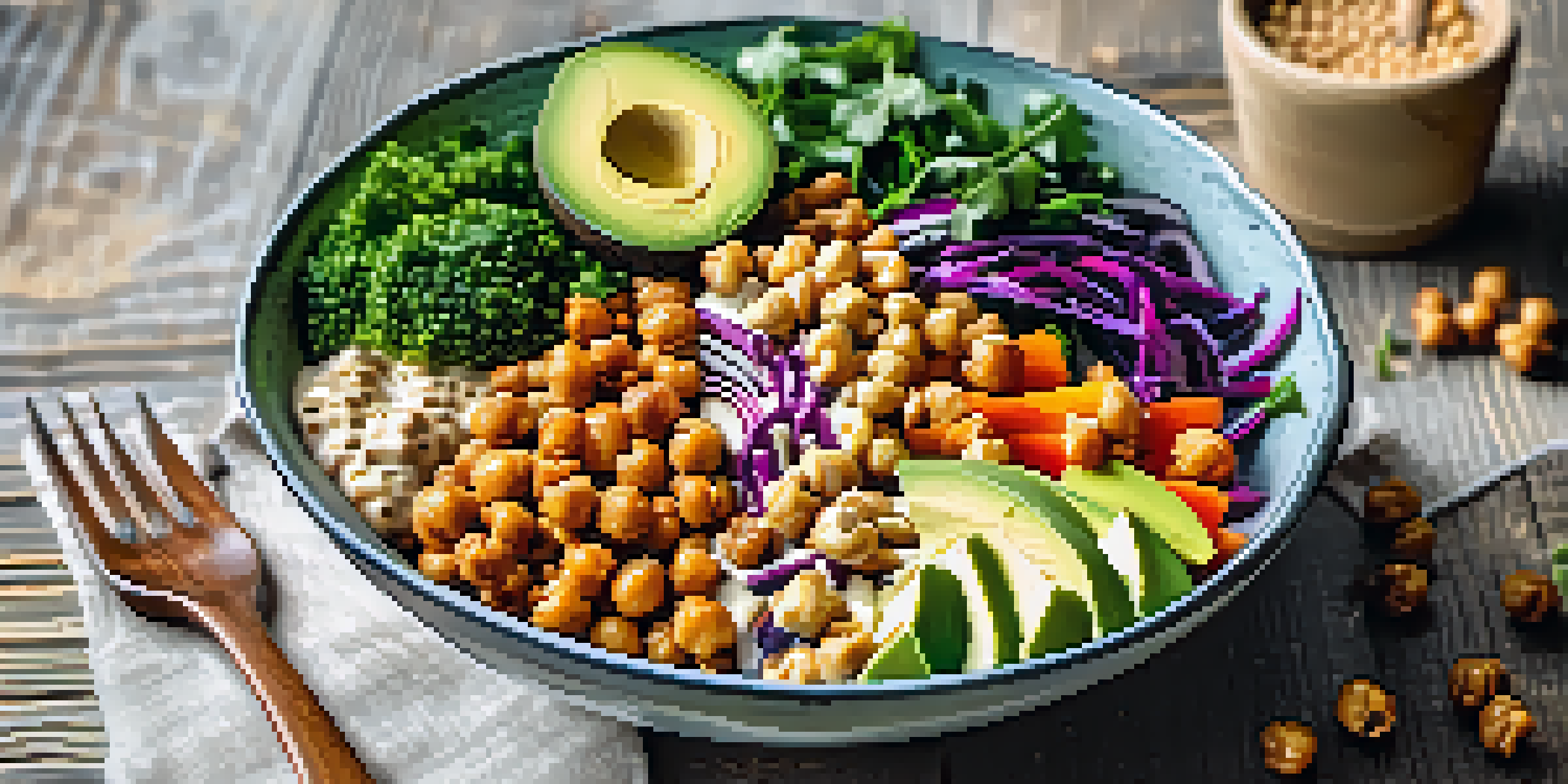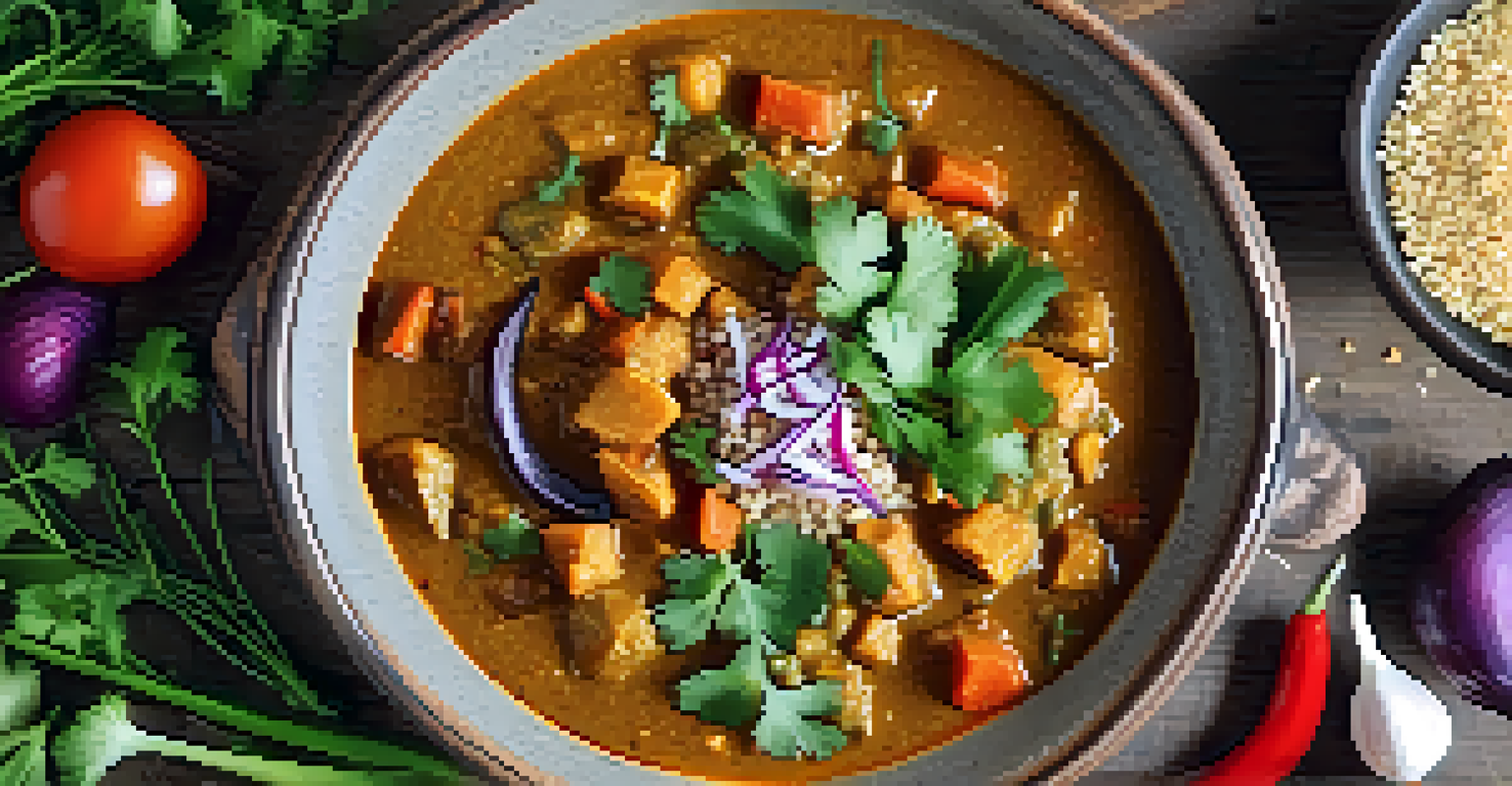Texture and Flavor: Creating a Balanced Vegan Experience

Understanding the Importance of Texture in Vegan Dishes
Texture plays a crucial role in how we experience food. In vegan cooking, where meat is absent, achieving a satisfying mouthfeel becomes essential. Think about how a crispy salad contrasts with creamy avocado; these textures keep the palate engaged and excited.
The only thing better than a good meal is a good meal shared with friends.
When preparing vegan meals, consider incorporating various textures like crunchy, chewy, and smooth. For instance, a grain bowl topped with roasted chickpeas, fresh veggies, and a tahini dressing creates a delightful mix. This approach not only enhances the eating experience but also adds visual appeal to your plate.
Ultimately, balancing textures can transform a simple dish into an extraordinary one. By thoughtfully layering ingredients, you can create a vegan meal that feels just as satisfying as its non-vegan counterparts, ensuring that no one misses out on a truly delightful dining experience.
Exploring Flavor Profiles to Elevate Plant-Based Meals
Flavor is the heart of any culinary experience, and vegan cooking offers a fantastic canvas for exploration. With an abundance of herbs, spices, and natural ingredients, you can create depth and complexity in your dishes. For instance, a dash of smoked paprika can add a surprising warmth to a simple vegetable stew.

Don't hesitate to experiment with global flavors. Ingredients like miso, nutritional yeast, and coconut milk can transport your dishes across continents. By embracing bold flavors from different cuisines, your vegan meals can become exciting adventures on the plate, appealing to a variety of tastes.
Texture Enhances Vegan Dishes
Incorporating a variety of textures, such as crunchy and creamy, elevates the overall dining experience in vegan cooking.
Remember, balance is key. Pairing strong flavors, like tangy lemon with earthy lentils, can create a harmonious dish that captivates the senses. This thoughtful approach to flavor will ensure that your vegan meals resonate with everyone, from seasoned vegans to curious omnivores.
Combining Ingredients for Optimal Flavor and Texture
The magic of cooking often lies in how ingredients interact with one another. In vegan dishes, combining ingredients that complement both flavor and texture can make all the difference. For example, mixing roasted sweet potatoes with black beans not only provides a delightful contrast but also delivers a well-rounded flavor profile.
Food is symbolic of love when words are inadequate.
When creating a meal, think about how different elements can work together. A crunchy slaw can be the perfect counterpoint to a soft, creamy vegan taco filling. This interplay not only enhances the eating experience but also encourages a variety of nutrients on your plate.
Incorporating contrasting ingredients can elevate your dishes from ordinary to extraordinary. By being mindful of how flavors and textures can harmonize, you can craft a vegan experience that is as enjoyable as it is satisfying.
Utilizing Techniques to Enhance Texture and Flavor
Cooking techniques can profoundly influence the final texture and flavor of your vegan dishes. For instance, roasting vegetables caramelizes their natural sugars, bringing out a sweeter flavor while creating a crispy exterior. This technique can transform mundane carrots into a vibrant dish bursting with flavor.
Consider also methods like grilling or sautéing to add depth. Grilling can impart a smoky flavor that enhances the overall dish, while sautéing with garlic and onions can create a fragrant base that elevates any meal. These techniques not only improve taste but also introduce varied textures.
Flavor Profiles Add Depth
Exploring diverse flavor profiles through herbs and spices can transform plant-based meals into exciting culinary adventures.
By mastering different cooking methods, you open up a world of possibilities for your vegan meals. This not only helps in achieving the desired flavor and texture but also fosters creativity in the kitchen, allowing you to experiment with various ingredients.
Layering Flavors: The Art of Building a Vegan Meal
Building layers of flavor is an art that can take your vegan cooking to the next level. Start with a solid base, such as a seasoned grain or a flavorful broth, and then add components gradually. Each ingredient should contribute to the overall experience, creating a symphony of tastes.
For example, when making a vegan curry, begin with aromatics like onions and garlic, then add spices to bloom before introducing your vegetables. This layered approach ensures that each bite is packed with flavor, making your meal not just delicious but also memorable.
In essence, layering flavors is about patience and attention to detail. By taking the time to develop each component, you create a vegan dish that resonates with depth and richness, exciting the palate with every bite.
Incorporating Seasonal Ingredients for Freshness
Using seasonal ingredients can greatly enhance both the flavor and texture of your vegan meals. Fresh produce often boasts superior taste and texture, making it a delightful addition to any dish. For instance, ripe summer tomatoes are juicier and more flavorful than their off-season counterparts.
Shopping for seasonal ingredients encourages creativity in the kitchen. You might find yourself experimenting with unique fruits and vegetables you wouldn’t typically use. This not only supports local farmers but also allows your meals to reflect the changing seasons.
Layering Flavors Creates Richness
Building layers of flavor in vegan dishes ensures that each ingredient contributes to a memorable and satisfying meal.
By embracing seasonal cooking, you can elevate your vegan dishes, ensuring they are fresh, vibrant, and packed with flavor. Plus, it adds an element of sustainability to your cooking, contributing positively to the environment.
Balancing Sweet and Savory for a Complete Experience
A harmonious balance between sweet and savory flavors can create a delightful contrast in vegan dishes. Sweet elements, like roasted butternut squash or a drizzle of maple syrup, can enhance savory ingredients like kale or lentils. This interplay keeps the palate intrigued and satisfied.
Consider a dish like a quinoa salad topped with dried cranberries and a tangy vinaigrette. The sweetness of the cranberries complements the earthy quinoa, resulting in a well-rounded flavor profile. This balance is essential in keeping meals exciting and enjoyable.

Ultimately, experimenting with sweet and savory combinations can lead to unexpected culinary delights. Striking the right balance will make your vegan dishes not only satisfying but also memorable for everyone at the table.